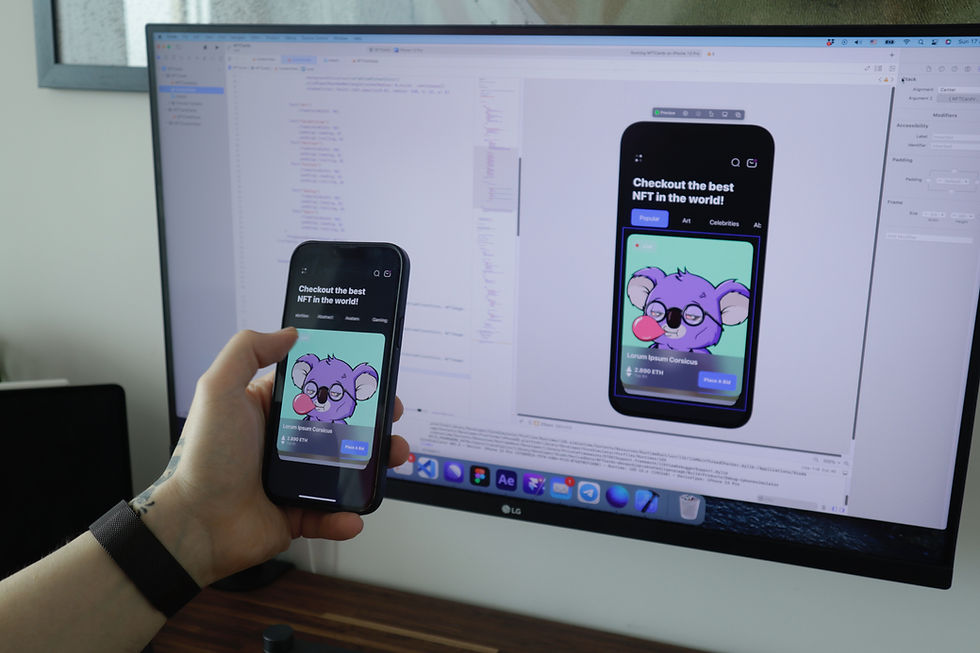Using SwiftyGif to simplify GIF Handling in iOS
- Don Peter

- Jan 16, 2024
- 2 min read
Updated: Jan 17, 2024

GIFs have become a staple in enhancing user engagement and interactivity within iOS applications. However, the complexities of handling GIFs programmatically often pose challenges for developers.
Enter SwiftyGif, a powerful open-source Swift library designed to streamline the process and provide developers with a robust set of tools for efficient GIF integration.
In this comprehensive guide, we'll start by understanding why SwiftyGif is a crucial addition to your iOS development toolkit.
Why SwiftyGif?
Traditional GIF handling in iOS development can be intricate and time-consuming. SwiftyGif addresses these challenges by introducing a specialized SwiftyGifView – a dedicated UIImageView subclass. This not only simplifies the process of loading and playing GIFs but also offers an intuitive interface for developers.
Integrating SwiftyGif
SwiftyGif's ease of integration sets it apart, offering support for various essential features that enhance the overall user experience.
1. Swift Integration Process
To get started with SwiftyGif in your iOS project, follow these simple integration steps using popular package managers:
CocoaPods:
pod 'SwiftyGif'Carthage:
github "SwiftyGif/SwiftyGif"Swift Package Manager:
Add the package with the URL https://github.com/SwiftyGif/SwiftyGif.git for compatibility with Swift Package Manager.
2. Simple API for Seamless Integration
Once integrated, SwiftyGif offers a straightforward API, simplifying the process of incorporating GIFs into your iOS app. The library extends support for crucial features, including playing, pausing, loop control, animation speed adjustment, and handling tap events on GIFs.
let gifImageView = SwiftyGifView()
gifImageView.setGifImage(gif)At the core of SwiftyGif is its specialized SwiftyGifView, a subclass of UIImageView. This subclass is meticulously designed to streamline the process of loading and playing GIFs within iOS applications. By introducing this dedicated view, SwiftyGif provides developers with an intuitive interface, making GIF handling more accessible and efficient. In this snippet, we instantiate a SwiftyGifView and effortlessly load a GIF using the setGifImage method. SwiftyGif's design philosophy is evident here, aiming for a smoother and more developer-friendly experience.
Advantages of SwiftyGif
Now that we've covered the integration steps, let's delve into the key advantages that make SwiftyGif a must-have tool for iOS developers.
1. Empowering Programmatic Control
SwiftyGif empowers developers with granular programmatic control over GIFs. This flexibility extends to adjusting playback speed, allowing for a tailor-made user experience.
The following code snippet illustrates this control:
let gifManager = SwiftyGifManager(memoryLimit: 20)
let gifImageView = SwiftyGifView()
gifImageView.setGifImage(gif, manager: gifManager) gifImageView.speed = 2.0 Adjust to your coding tempo!
Developers can fine-tune the animation speed dynamically, providing a level of control that enhances user engagement.
2. Smooth Playback - A Symphony of Efficiency
At the core of SwiftyGif's design philosophy lies optimal CPU and memory usage. The library ensures buttery-smooth animations, even with large GIFs, preserving app responsiveness and efficiency.
3. Mastering Memory Management
SwiftyGif introduces the companion class SwiftyGifManager, enabling developers to take command of memory management. This class allows setting memory limits, preventing slowdowns, and optimizing resource allocation:
let gifManager = SwiftyGifManager(memoryLimit: 20)
let gifImageView = SwiftyGifView()
gifImageView.setGifImage(gif, manager: gifManager)Efficient memory utilization becomes particularly crucial when dealing with multiple GIFs, and SwiftyGif simplifies this aspect.
4. Unlocking Remote Loading Capabilities
SwiftyGif takes the GIF experience a step further by allowing dynamic content display and seamless integration of user-generated GIFs through remote loading from URLs:
let remoteGifURL = URL(string: "https://example.com/your_gif.gif") let gifImageView = SwiftyGifView() gifImageView.setGifFromURL(remoteGifURL)This capability enhances the library's versatility, enabling developers to incorporate GIFs from external sources effortlessly.
Conclusion
Embarking on a GIF-tastic journey with SwiftyGif means letting the library do the heavy lifting, allowing developers to focus on coding logic.
To explore further nuances, advanced features, and best practices, visit the documentation here.



Comments